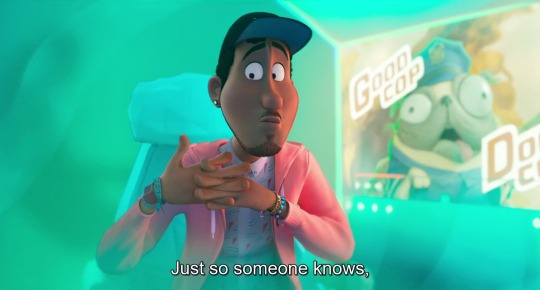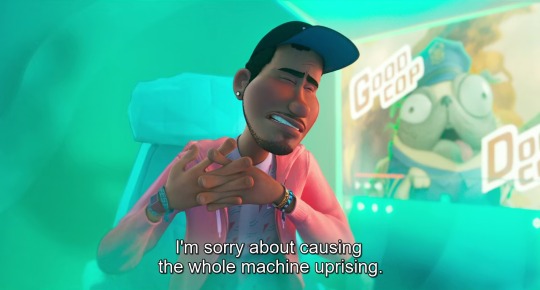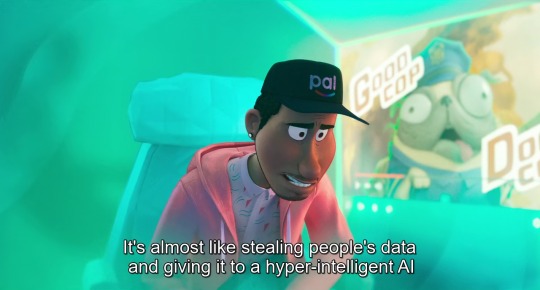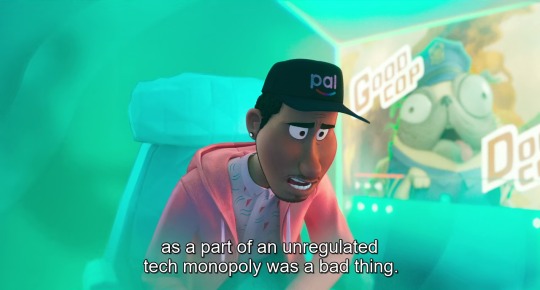#Problem solving
Explore tagged Tumblr posts
Text






(from The Mitchells vs. the Machines, 2021)
#the mitchells vs the machines#data privacy#ai#artificial intelligence#digital privacy#genai#quote#problem solving#technology#sony pictures animation#sony animation#mike rianda#jeff rowe#danny mcbride#abbi jacobson#maya rudolph#internet privacy#internet safety#online privacy#technology entrepreneur
12K notes
·
View notes
Text

#quotes#spiritual#inspiration#life#soul#inspirational#spirituality#universe#love#spirit#motivation#problem#solve#problem solving#motivational#motivating quotes#motivación#get motivated#spiritua#spiritual awakening#spiritual awareness#spiritual community#spiritual development#spiritual healing#spiritual journey#spiritualgrowth#spiritualguidance
371 notes
·
View notes
Text



244 notes
·
View notes
Text
I'm not stupid. my brain simply refuses to retain information.
#ADHD#utterly destroys my capacity to remember shit#“oh you don't remember”?#no and that's not bc i willingly forgot#or wasn't paying attention#there's plenty of ways to measure intelligence#reasoning#problem solving#critical thinking#adaptation
51 notes
·
View notes
Text
Problem & worry - See caracal wild cat video
Why worry if problem can be solved? Will worrying help if problem can't be solved? - Dr Devang H Dattani
Good Morning
See Video For Caracal Wild Cat Behavior - Secretive Nocturnal
Quote / Poem / Poetry / Quotes Of
Bhagwan Sri Sri Sri
Doctor Devang H Dattani
Infinite SriSriSri DDD
Posted By TheBlissCity DDD Team
See The Media Photo Video For
Quoteoftheday
God Morning
#problem , #solve , #bliss , #TheBlissCity , #philosophy , #mindfulness , #DrDevangHDattani , #nature , #awareness , #InfiniteSriSriSriDDD , #quotes , #life , #art , #zen , #awakening , #quote , #spirituality , #photography , #Video , #meditation , #psychology , #poem , #poetry , #motivation , #inspiration , #quoteoftheday , #love , #words , #thoughts , #joy , #pun , #enlightenment , #health , #mental health , #consciousness , #good , #god , #life , #thoughts , #nirvana , #tantra , #yoga , #help , #problems , #solutions , #worry , #photooftheday , #panorama , #wild animal , #caracal , #video #landscape , #wild cats , #behaviour , #secretive , #nocturnal , #cats , #cats of tumblr , #cute animals , #kitties , #wild life
#artists on tumblr#worry#caracal#photographers on tumblr#cotl#cats of tumblr#problem solving#arcane#inspiration#mental health#mcr#wellness#wellbeing#motivation#TheBlissCity#DrDevangHDattani#InfiniteSriSriSriDDD#philosophy#mindfulness#naturecore#awareness#quotes#art#awakening#spirituality#photography#video#meditation#psychology#wildlife
56 notes
·
View notes
Text

Life hack
#funny#humor#funny memes#meme#lol memes#lol#memes#haha#memecreator#working#the office#problem solving
27 notes
·
View notes
Text

#breathe#mindfulness#coping#coping skills#difficult times#you will be okay#you will get through this#the only way out is through#don't give up#keep going#self compassion#self care#problem solving#stop the spiral
169 notes
·
View notes
Text
The most annoying sentence online, especially after current events, is "we're cooked".
It is a sentence that ends problem solving thought and encourages doomerism.
Instead, say "there's a problem, how do we go forwards from here?"
Start cooking instead of being cooked.

#anti doomerism#doomerism#hopepunk#hopecore#activism#cooked#we're cooked#advice#life advice#problem solving#activist#gif
38 notes
·
View notes
Text
Thorn had just stated that some problems could only be solved alone. She felt the need--a little childishly, admittedly--to prove to him that others could only be solved together.
— Christelle Dabos, The Storm of Echoes
#christelle dabos#the storm of echoes#the mirror visitor#problem solving#partnership#relationships#book quotes#books#Q:
24 notes
·
View notes
Text
Not everything that is faced can be changed, but nothing can be changed until it is faced.
James Baldwin, in Remember This House.
#quotes#james baldwin#remember this house#problem solving#wisdom#life#life advice#life quotes#adulting#reminders#life tips#advice#note to self
13 notes
·
View notes
Text
"(...) Draw your chair up, and hand me my violin, for the only problem which we still have to solve is how to while away these bleak autumnal evenings."
"The Illustrated Sherlock Holmes Treasury" - Sir Arthur Conan Doyle
#book quotes#the adventures of sherlock holmes#sir arthur conan doyle#the adventure of the noble bachelor#sherlock holmes#john watson#grab a chair#violin#problem solving#bleak#autumnal#evenings#autumn nights
38 notes
·
View notes
Text
I combined TPS with CKR and this is what came out
I don't know why but Pure Vanilla's voice sounds very similar to that of Horace, it's curious or maybe a little of his voice remains
#problem solverz#alfe#roba#cookie run kingdom#shadow milk cookie#horace#pure vanilla cookie#problem solving
11 notes
·
View notes
Text
PERCAYALAH, setiap takdir yang membuatmu menangis, pasti ada akhir yang sangat manis, setiap perjuangan yang susah, pasti membuahkan hasil yang indah.
Berkembanglah dan jangan berhenti di jalan, karena tidak ada hidup tanpa masalah, tidak ada perjuangan tanpa rasa lelah.
"Aku mencintai permasalahanku, karena kutahu YANG MEMBERI PERMASALAHAN juga mencintaiku."
~ Rumi
#gus dur#rumi#humor#video lucu#lelucon#problem solving#selfreminder#self improvement#self love#self care#allahuakbar#allah#tuhan#reminder#islamic quotes#islamicreminder#islamic life#nu#nahdlatul ulama#mindset#attitude#healing#quotes#life#quote#indonesia#positif#motivasi#muslim#cinta
16 notes
·
View notes
Text
tumblr note: this is a living document. tap the original post header to see if it's been updated since this reblog.
This post will also be available at https://juh.gay/essays/solvethink.md.
solvethink
Let's look at a silly problem I face in my daily life as an example. There's a great cheesesteak place near my work, but they're only open 10am to 4pm. I would eat there every time I drove past if I could. Can I get an American wit onion today? We'll look at this problem, and a few others, with the tools I use to solve problems every day.
Partition the problem (dichotomies)
Here on tumblr we usually hear about dichotomies in the context of "nice dichotomy idiot! what lies outside it?". Dichotomies are a useful tool, dangerous in the hands of idiots, just like any other useful tool. Since "di" means "two", I'm going to use "partition" from now on, because there are often more than two options.
When faced with multiple potential scenarios, try splitting the problem in a way that captures all the possible choices or outcomes, but groups them to be easier to think about. We must construct our partition thoughtfully:
If anything lies outside the options you've listed, you risk being unprepared for edge cases. Sometimes that's okay, sometimes it's not. You'll have to decide that based on the problem.
If you have too many options to think about, partitioning this problem might not be the best approach (or you're in a real pickle).
If your partition doesn't help you reason about the outcomes, try a different way of splitting things. Think about the possible outcomes and what circumstances create them.
The only problem I have with Calozzi's is the hours, because I'm non-24 and work at weird times and sometimes can't get out of bed for a couple of days. Suppose I leave for work. Will they be open?
If I get there too early or too late, they'll be closed.
If I get there during business hours, they'll be open.
This is correct, and we can do a little with it, but we could make it more useful by dividing the clock further:
If I arrive too early, they'll be closed, but I can go in a little bit. I might as well do some work first.
If I arrive early in their business hours, they'll be open. I can go now if I'm hungry, or I can work first and then head over in a couple of hours.
If I arrive late in their business hours, they'll be closed soon. I should go now.
If I arrive too late, they'll be closed. No philly. :(
Compare outcomes
This one is fun. Build a table of the options you have, and list their outcomes. Next, eliminate the outcomes they have in common. What's left is the real effect of each option. Anything they have in common isn't really a part of the choice, it's going to happen anyway. Those common outcomes are important too! This tool sheds light on what is in your control, and what is not.
Let's set aside the cheesesteaks for a minute and look at a really frustrating recent example: the 2024 US presidential election. People (and bots) pushed this idea that the candidates were the same, the parties were the same. People took the stance that they would be "single-issue voters" about the war on Gaza. That was about the dumbest possible thing to do. Let's look at the train of thought:
I'm only going to vote based on who will end a genocide.
I don't believe either candidate will end the genocide.
Therefore, I'm not going to vote.
Do you see the obvious fucking problem here?? Suppose that 2 is accurate. "Not ending the genocide" would appear in both columns when we compare the outcomes. We cross it out. Make a decision on what's left! Why would you make a choice based on an issue where you have no choice? This is an absolutely essential critical thinking skill that far too many people are without, and I am mad about it. I'm happy that you're learning about it, but I'm still mad that other people have put me and my family in danger because they couldn't reason about decision making. Sorry. Rant over.
Determine thresholds and cutoffs
Sometimes a problem takes the form of "we don't have enough support for this" or "how long can we keep doing this". Ask the question: How much is enough? Where do we draw the line? What's the cutoff?
Going back to the happy sandwich example, let's enhance our partition a bit by clearly defining the lines between the options. Factoring in travel time from work to the restaurant, and considering I don't want to get there right before closing:
If I get to work before 0940, they won't be open yet.
If I get to work between 0940 and 1200, that's early in their business hours.
If I get to work between 1200 and 1515, that's late in their business hours.
If I get to work after 1515, it's too late.
Reexamine relationships
Sometimes things are not exactly as they seem, or how they're first presented to you. Maybe the steps in this process don't actually have to go in that order. Maybe one of them isn't even necessary. Maybe this cause-effect system isn't actually cause and effect. Question why the problem is constructed the way that it is, and see if maybe it can be turned into an easier problem.
Tangential to cheesesteaks, let's talk about how I commute in general.

I used to go Home -> South Work -> Calozzi's -> North Work -> Home. But these don't have to go in that order. What are the real constraints?
Start at home
End at home
Visit both work sites during the trip
Get a cheesesteak if possible
I get tired easily while driving, so I need to avoid doing too much of it at once
I get more tired as the day wears on
They're all on basically the same road. Driving to North Work takes me right past Calozzi's and South Work, as does driving back
To optimize this route, we have to know, what are we optimizing for?
Time: Traveling back and forth along the full length of the route can't really be sped up. We can avoid making it worse than the naive route by just, not driving back and forth over and over again.
Gas money: Same deal, naive route is about as good as we can do.
Fatigue: Bingo. I get more tired as the day drags on, and we have multiple legs of different lengths that pose different fatigue hazards.
Now that we have something to optimize:
Let's start with the long leg of the commute, Home to North Work, when I'm freshest and least likely to fall asleep at the wheel. This will take me about an hour and change on the road.
Then we go from North Work to South Work, about half an hour on the road. I can do my work and take a nap in the parking lot before I leave if need be.
Then we head home, about 40 minutes.
So where does the steak come in? Whenever it can, basically. If they're open on the way up, I'll stop in; if not, but they're open on the way back, then I'll stop in; otherwise, no sando.
Decide what the problem is
If you're chasing a problem but can't seem to formalize the possible outcomes or choices available to you, double check that you actually know what the problem is. You can't solve a problem that you don't recognize. If you feel like you're swimming through a thick fog of thoughts and getting nowhere, start here.
This was essential to dealing with my anxiety about flights. I knew I felt sick to my stomach before flights even if I hadn't eaten anything spooky lately, and I knew I was anxious, but I didn't know why, or how to fix it. I sat down and thought about it one day. Let's partition the experience:
Packing for the flight
Getting to the airport
Getting through the airport (security and to the gate)
The plane ride itself
Getting through the other airport
Getting to my final destination
I realized that after I'm through security, I feel waaay better. My stomach is still unhappy, but the anxiety is gone. That narrows down the problem!
Packing for the flight: Am I anxious about packing wrong? Yes. Clarify: I'm worried that I'll forget to pack something.
Getting to the airport: Am I anxious about getting there? Yes. Clarify: I'm worried that I'll get stuck in traffic and end up late.
Getting through security: Am I anxious about getting through security? Yes. Clarify: I'm worried that something in my backpack will be confiscated.
We've identified the problems! From there, it was fairly easy to find solutions. Security and packing are basically the same concern: what if I arrive without something I need? Let's partition my belongings:
Things I can replace cheaply: clothes, chargers, toothbrush, razor, anything owned by work
Things I could replace but they're expensive: personal electronics
Things I cannot replace: data (which is on personal electronics) (backups are important and i am failing)
Okay, let's look at the things I cannot replace. Laptop and phone will not be confiscated during normal operations, so my data is as safe as I can hope for. I'm generally not carrying anything that is both personal and expensive, other than those we just mentioned. Everything else can be replaced cheaply, which means that if I forget it, I can run to a store and get another one, and it's no big deal. This problem is solved!
Getting to the airport is the other issue. The concern is that I'll get stuck in traffic and miss my flight. This is a probabilistic outcome, one that I cannot fully prevent or guarantee. What can we do to minimize the chance or impact of getting stuck in traffic?
Leave early. More buffer time means more time that can be eaten by traffic. Cost is waiting around in car-and-airport for more time, not a big deal.
Understand the traffic patterns and book flights accordingly. At my airport, rush hour traffic is bad, midday is fine, midnight is great. If I can avoid arriving at the airport in the morning or the afternoon, the chances of encountering traffic are greatly reduced.
And there we go! My anxiety about flying is gone (unless I'm running late), and my stomach is somewhat better. I've also taken to fasting for a day before flights though, just to be safe.
Written lists
When tackling a problem with a lot of steps, or a lot of outcomes to sift through, or too many partitions to keep track of, it often helps me to write them down somewhere. I keep two whiteboards and a legal pad in my backpack at all times just in case, and I have notes on my phone at the ready. This isn't necessary for most problems I deal with, but it can help if there's a lot going on or my brain isn't working. Writing things down enables your brain to quit storing them in L1 cache. I'm fond of saying: I don't write things down so I can remember, I write things down so I can forget. (Coincidentally, it helps with the remembering too.)
Spreadsheets are another super valuable tool. I love spreadsheets. They're 2D lists, you can copy-paste, you can do math real easy, you can lay things out however you want, you can even filter tables and write pseudo-sql queries if you need to. You can get a new google sheet by visiting sheets.new any time.
Draw patterns from examples
If you're working with a lot of variables, or a fairly underspecified problem, try coming up with some example cases and see how they pan out. Try changing one thing about each case and see how it affects the outcome. Are there patterns in how things turn out? Can you infer anything useful about how the problem works with this information? Can you work the problem backward to see how each choice impacts the outcomes?
Define upper and lower bounds
Sometimes it's helpful to find the upper and lower bounds on some variable in a problem. Looking for best- and worst-case outcomes is an example of this: we can't say that the final outcome will be smack in the middle (argument to moderation fallacy), but we know it will be somewhere between those two, inclusive. In the cheesesteak example, we can define bounds on when I can arrive at work and get a sandwich right away: no earlier than 0940, and no later than 1515. From here, given 40 minutes of driving, we can deduce that I should leave home between 0900 and 1435 if I'm hungry, although I could head in before 0900 and get more work done first.
Evaluate feasibility
Ask if it can even be done. Can you prove that it's possible? Can you prove that it's impossible? How do you find out? If you can write the entire problem off as impossible, that saves a lot of work.
Build realistic plans
"He who knows himself and his enemy is gonna be fine" -- Shadow the Hedgehog or whatever
When we plan motion for robot motors, we generally don't drive the motor at full output, because we can't model the way it moves that well: it's affected by fluctuating voltages, motor temperature and thermal expansion, friction, and a host of other variables that are hard enough to model that we usually just don't. Instead, we pick a speed just a little below what we know it can do at full cook, and we ask it to do that. This way, we know we're going to get what we asked for, every time, and we can use that to do a bunch of math and make things work way smoother.
When you're building plans, don't assume that things will go perfectly---assume that they won't. Accept that you might have a slow morning and you might miss the first bus, and maybe the second one too. Remember that you and your friends get distracted easily and aren't going to finish this task in the optimal time frame. Plan to cut twice on occasion, it happens. We are not perfect! And that's okay! If you plan for imperfection, you can execute that plan perfectly.
You must know your enemy, too: there will be obstacles that are not your fault, beyond your control. Are there likely or predictable issues? Are there possible but unpredictable issues? What can you do about them?
Build buffers into timelines and resource requirements. If you can, estimate how big those buffers need to be based on where and how you think slips are likely to happen. Also consider the cost of running out of something: Does it cost you money? Time? How much? What questions and paperwork will be involved? Is the potential cost of a slip worth the cost of building in more buffer?
Conclusion
Some of these will sound like common sense, some will sound novel and difficult, and some might sound like your mother telling you it's not that hard. Try applying these to problems in your everyday life, and with practice they can become second nature. I always get a kick out of reducing a problem from broad and vague to a small set of options with outcomes that are easy to choose between. Feel free to reblog with problem solving tools that you use!
#living document#resource#bookmark#problem solving#critical thinking#education#bathroom wall#us politics#cheesesteak#planning#advice
13 notes
·
View notes